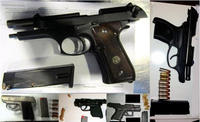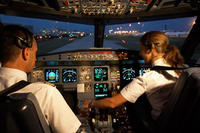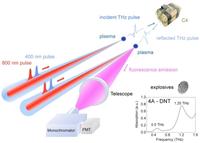-
Airports yet to be affected by sequestration-related cuts
Since sequestration went into effect last Friday, both airport authorities and DHS have been saying that that passengers should prepare themselves for longer wait times at security checkpoints. So far, airports in major cities have reported no discernible increase in wait time at security lines.
-
-
TSA would allow knives on planes beginning 25 April
The Transportation Security Administration (TSA) yesterday announced that, starting 25 April, the prohibition against carrying knives on board would be lifted. TSA would also allow other items banned since 9/11, such as lacrosse sticks, ski poles, and small, souvenir baseball bats. The flight attendants union was quick to condemn to move, calling the decision “dangerous” and “designed to make the lives of TSA staff easier, but not make flights safer.”
-
-
FAA investigates on-board dance
Last month the Colorado College ultimate frisbee team, along with other passengers, took part in a YouTube sensation known as the Harlem Shake during a packed flight on Frontier Airlines from Colorado Springs to San Diego. The FAA is now investigating whether safety regulations were violated.
-
-
Increasing the sensitivity of airport security screening
The latest episode in the American Chemical Society’s (ACS) Global Challenges/Chemistry Solutions podcast series reports a simple way to improve the sensitivity of the test often used to detect traces of explosives on the hands, carry-ons, and other possessions of passengers at airport security screening stations.
-
-
Blast-resilient carriages to reduce impact of a terrorist attack on trains, metros
Engineers have developed a blast-resilient carriages which are better able to withstand a terrorist attack and ultimately save lives. The engineers have e focused on two key areas — containing the impact of the blast and reducing debris — the main cause of death and injury in an explosion and the key obstacle for emergency services trying to gain access to injured passengers.
-
-
Revealing full-body scanners to be removed from airports
One of the more controversial post-9/11 security devices, the ubiquitous and uncomfortably intrusive full-body scanners, will be removed from service by the Transportation Security Administration (TSA). On Friday, the agency announced it would begin to remove the scanners from U.S. airports this summer. The anatomically revealing backscatter scanners are being replaced by the ore discreet millimeter wave devices.
-
-
TSA hits new record in gun collection at airports in 2012

The Transportation Security Administration (TSA) set a new record by confiscating 1,500 weapons in 2012, with 1,295 of the weapons being loaded; most of the confiscated weapons at airports are guns, but TSA has also caught passengers trying to board planes with grenades, stun guns, axes, and throwing stars; one passenger tried to board a plane carrying a bazooka, and another passenger was trying to bring a rocket launcher on board
-
-
Experts warn of growing threat to aviation: pilot fatigue

Safety expert criticizes EU proposals to relax flight-time limits; his study of pilots’ work found that over 20 percent of them said that by the time they completed their shift, they had been awake for twenty-eight hours or more
-
-
GPS technology helps track, monitor airfield anomalies
When we hear the term “airfield anomalies,” we may think of something serious such as a fire on a runway or a terrorist plot’ most of the time, however, the term could mean something as minor as birds on the runway; a new reporting system makes it easier to track and record such anomalies
-
-
U.S. cuts budget for nuclear monitoring at foreign ports
In 2003 the United States decided to install radiation detection equipment in 100 large ports around the world, and train local personnel in using the equipment, so that ship containers could be scanned for nuclear material before the ship left for the United States; so far, equipment has been deployed in forty-two ports; after GAO criticism of the quality of the scanning equipment and of lack of coordination between two similar container scanning programs, the National Nuclear Security Administration’s 2013 budget will be cut by 85 percent, and further installations will be canceled
-
-
Modeling terrorism risk to the air transportation system
RAND recently evaluated a terrorism risk modeling tool developed by the Transportation Security Administration (TSA) and Boeing to help guide program planning for aviation security; the Risk Management Analysis Tool, or RMAT, simulates terrorist behavior and success in attacking vulnerabilities in the domestic commercial air transportation system, drawing on estimates of terrorist resources, capabilities, preferences, decision processes, intelligence collection, and operational planning
-
-
Terahertz waves for explosives detection

The chips generate and radiate high-frequency electromagnetic waves, called terahertz (THz) waves, which fall into a largely untapped region of the electromagnetic spectrum — between microwaves and far-infrared radiation — and which can penetrate a host of materials without the ionizing damage of X-rays; when incorporated into handheld devices, the new microchips could enable a broad range of applications in fields ranging from homeland security to wireless communications to health care, and even touchless gaming
-
-
The potential for self-driving cars in the U.K.
Researchers explored what it would take for driverless vehicles to become commonplace on U.K. roads; they highlight the potential benefits of self-driving cars, such as increased road safety and less traffic, but stress that a range of barriers need to be overcome before people buy them en masse
-
-
Improved technology to detect hazardous chemicals
Scientists have developed a system quickly to detect trace amounts of illegal drugs, explosives, pollutants in rivers, or nerve gases released into the air; the new system can pick out a single target molecule from 10,000 trillion water molecules within milliseconds, by trapping it on a self-assembling single layer of gold nanoparticles
-
-
Mathematicians offer new way for aircraft boarding
Air passenger transportation in China has increased to 200 million in 2010 from less than 10 million in 1950; the increase of the supply of air transportation, however, is much slower than that of its demand; thus, in practice, conflicts between supply and demand often occur, leading to airline congestions, passenger-luggage congestions, and mixed traffic problems; researchers offer a solution to the problem
-
- All
- Regional
- Water
- Biometrics
- Borders/Immig
- Business
- Cybersecurity
- Detection
- Disasters
- Government
- Infrastructure
- International
- Public health
- Public Safety
- Communication interoperabillity
- Emergency services
- Emergency medical services
- Fire
- First response
- IEDs
- Law Enforcement
- Law Enforcement Technology
- Military technology
- Nonlethal weapons
- Nuclear weapons
- Personal protection equipment
- Police
- Notification /alert systems
- Situational awareness
- Weapons systems
- Sci-Tech
- Sector Reports
- Surveillance
- Transportation
Advertising & Marketing: advertise@newswirepubs.com
Editorial: editor@newswirepubs.com
General: info@newswirepubs.com
2010-2011 © News Wire Publications, LLC News Wire Publications, LLC
220 Old Country Road | Suite 200 | Mineola | New York | 11501
Permissions and Policies
Editorial: editor@newswirepubs.com
General: info@newswirepubs.com
2010-2011 © News Wire Publications, LLC News Wire Publications, LLC
220 Old Country Road | Suite 200 | Mineola | New York | 11501
Permissions and Policies
